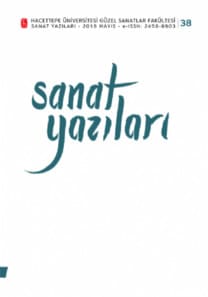YAZI KARAKTERİ VEYA FONT TASARIMINDA SÜREÇ, YÖNTEM VE TEMEL YAKLAŞIMLAR
PROCESS, METHODS AND BASIC APPROACHES IN TYPEFACE OR FONT DESIGN
___
Brody, N., Wozencroft, J. (2012). Fuse 1-20 – From Invention to Antimatter: Twenty Years of Fuse. Köln: Taschen GmbH, Germany.Carter, R., Day, B., Meggs, P. (1981). Typographic Design: Form and Communication. New York: Van Nostrand Reinhold.
Chappel, Warren. (1970). A Short History of the Printed Word. New York: Alfred A. Knopf Publishing.
De Vinne, Theodore L. (1900). The Practice of Typography: A Treatise on the Processes of Type-making, the Point System, the Names, Sizes, Styles and Prices of Plain Printing Types. New York: The Cencury Co.
Godine, David R. (1973). The Art of the Printed Book 1455-1955: Masterpieces of Typography Through Five Centuries from the Collections of the Pierpont Morgan Library. NewYork: USA.
Google. Erişim: 17.11.2020. https://m.media-amazon.com/images/M/MV5BMTUyMDU4NzE0Nl5BMl5BanBnXkFtZTgwMzg0MDQyMTI@._V1_UX182_CR0,0,182,268_AL_.jpg).
LaCroix, S., Jones, B. (Yapımcı), Oakes, B. (Yönetmen). (2017). Abstract: The Art of Design (Jonathan Hoefler: The Font Design). [Belgesel]. USA: Netflix.
Lupton, Ellen. (2011). Graphic Design Thinking: Beyond Brainstorming. New York: Princeton Architectural Press.
Lorem Ipsum. Erişim: 02.12.2019. https://loremipsum.io/
Nesbitt, Alexander. (1957). The History & Technique of Lettering. New York: Dover Publications.
OECD. Erişim: 10.02.2020. https://www.oecd.org/pisa/
Sarıkavak, Anıl. (2018). 20. Yüzyılda Tasarlanmış Önemli Fontların Dönemin Tasarım Anlayışlarıyla Etkileşimi ve Deneysel Font Çalışmaları. (Yayınlanmamış Yüksek Lisans Tezi). Selçuk Üniversitesi, Konya.
Sarıkavak, Namık Kemal. (2005-a). Sayısal Tipografi 1; Basımcılık ve Yayıncılıkta Aygıt, Donanım ve Yazılım Teknolojisinin Gelişimi. Ankara: Başkent Üniversitesi Yayınları.
Sarıkavak, Namık Kemal. (2005-b). Sayısal Tipografi 2: Batı’da ve Ülkemizde Sayısal Harf/ Font Tasarımcıları. Ankara: Başkent Üniversitesi Yayınları.
Sözlük. Erişim: 20.02.2020. https://sozluk.gov.tr/
Sutcliffe, Judith. (1996). Calligraphic Tutelage. Using Fontographer. s. 77-80. San Francisco: Macromedia Inc.
Uçar, Tevfik F. (2019). Görsel İletişim ve Grafik Tasarım. İstanbul: İnkilap Yayınevi.
- ISSN: 2458-8903
- Yayın Aralığı: 2
- Başlangıç: 2001
- Yayıncı: -
20. VE 21. YÜZYIL PERSPEKTİFİNDEN PARAMETRİK TASARIM
BAŞKA BİR GÜNDELİK HAYAT İNŞASINDA SANATIN İZLERİ
FOTOĞRAFIN DEĞİŞEN TUTUMLARI ÜZERİNE
YAZI KARAKTERİ VEYA FONT TASARIMINDA SÜREÇ, YÖNTEM VE TEMEL YAKLAŞIMLAR
MİMARİ FOTOĞRAFIN TEMSİL ÖZELLİĞİ VE TASARIMDA FOTOĞRAFA BAKIŞIN ALGIMIZA ETKİSİ
1936-1951 YENİŞEHİR - ÇANKAYA KONUT GELİŞİM AKSINDA İLK YAPILAŞMALAR: GÜNEŞ SOKAK ÖRNEĞİ
Birsel Bahar BACAK, Seher KURT
AZADEH AKHLAGHI’NİN DOKÜMANTER SANATI ÜZERİNDEN, SANAT VE TARİHİ GERÇEK İLİŞKİSİ
MİMARİ BELGELEMEDE TÜRK SİNEMASININ ROLÜ: TARABYA OTELİ ANALİZİ
JIMMY NELSON’UN ETNOGRAFİK FOTOĞRAFÇILIĞI VE KÜRESELLEŞME İLİŞKİSİ
